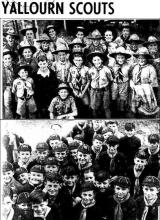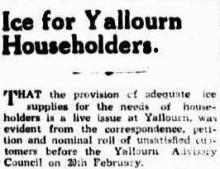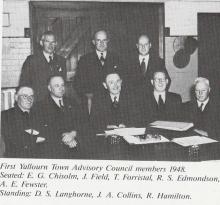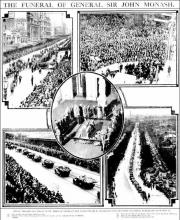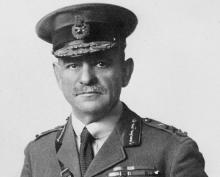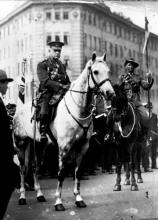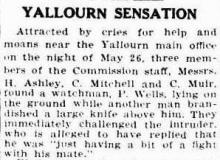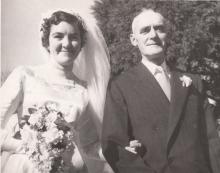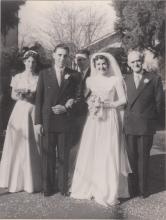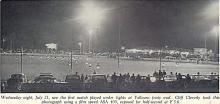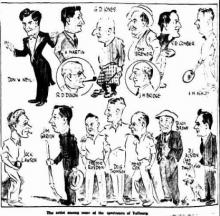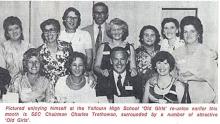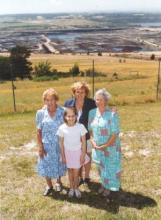FROM THE NEWSPAPERS - 2019 - FINAL THANK YOU
HISTORY PROJECT - ‘FROM THE NEWSPAPERS’
The idea of this project, ‘From the Newspapers’ was seen as a fitting way to highlight the selfless endeavours of the residents, of earlier days, who ‘paved the way’ in developing the township of Yallourn.
The series of articles commenced in January 2015; and, over the past five years, more than seventy extracts from various newspapers have focused upon local families, personalities, organisations and events of Yallourn since 1921.
The footnotes, which accompanied each story, tried to ‘shed further light’ on a particular period of the town’s history and tried to help younger readers appreciate what made Yallourn such a unique place.
A NOTE OF THANKS
Julie George and I would like to express our sincere thanks to:
(i) Former residents of Yallourn who forwarded anecdotes, information and photographs.
(ii) Readers who provided suggestions to augment the various articles in the project.
We would also like to acknowledge the following people for their interest in the articles and their assistance with the compilation of footnotes for the extracts…
• Peter Thwaites and John Farquharson.
• Julian Beck & Cecilia Olmos Vancouver (British Columbia Sporting Hall of Fame).
• Anna and Michael Meszaros ( Association of Sculptors- Victoria)
• Heather Barton (AM-Order of Australia).
• Frank Tabone (Latrobe Valley Maltese Festival).
• Philip Moses (Secretary, Australian Jewish Historical Society).
• David Langdon (Richmond Historical Society).
• Bryan McKenzie (ex-Swan Hill Genealogical & Historical Society).
• Bet Jenvey, (Research Officer for the S.H.G & H.S).
• Professor Jeffrey Rosenfeld (Monash Health).
• John Peck ( Trotting Historian), Kathy Gerbert (Harness Racing Australia ), Kyle Galley ( Warragul Harness Racing Club), Dean Baring, Michael Taylor and Flora Robson (Harness Racing fraternity).
• Dr Kay Steel (Federation University).
• Dr Julie Fenley-Churchill Campus (Monash University).
• Caroline Oxley- Research Officer- Victoria Police Museum.
• Justin Hosking (Hosking Lawyers- Rosebud).
• Kylie Best- State Library of Victoria.
• Staff - Rosebud Public Library.
• Staff- State Library of Victoria.
• Staff- City of Footscray Public Library.
• Staff-National Library of Australia
• Staff -The Australian War Memorial.
• Libraries Australia Help Desk staff.
• Michael Roberts-Historian Collingwood Football Club.
• Tony De Bolfo- Historian Carlton Football Club.
• Boyles Football Photos.
• Members of the Old Coal Museum at Yallourn North.
• Bruce McMaster & Florence Butcher- Morwell Historical Society.
• Moe Historical Society.
• Fran Clarke, Margaret Reid, ‘Mossie’ Williams, Lyn & Murray French, John & Lance White, John Hutchinson, Gaynor Gould (Fairclough), Grant & Dawn Cowley, Jim Richardson, Norm Hall, Andrew, Lyn & Elizabeth Spaull, Heather Stone, Victor Berquez, Stan Oakley, Barbara Bunting (Davine), Isobel Woodside (Docherty), Elaine Hosie (Verey), Veronica Barfoot (Lacey), Alison Bonnici, Frank Widdows, Leonie Godridge, Richard Bush, Heather Baker (Norden ), Kay Heeps (Spurrier) , Trevor McColl, Joan Ashmead, Chris Francis, Laurie Shipp, Paul Carter, Barry & Marion Spurrier, Bill Jackson, Dianne Goulding ( Stevenson ), Sue Van Dijk (Wallace), Lois Gust , Jim Watt (Jnr), Fae Horman (Lawson), Alan Ripper, Muffy Forsyth, Perry Middlemiss, Ian Fleming and Brian Handley.
TITLES IN THE PROJECT
The list of articles posted by Julie since 2015:-
2015
1 1934 Tiger Snake’s Fatal Meal Mr McClarty
2 1952 Heather MacKay wins a Bicycle Young Heather McKay
3 1934 A Day at the Melbourne Zoo Yallourn State School
4 1948 Excellent Exam Results Margaret Reid
5 1932 Young Boy Visits Melbourne Harry Rickard
6 1928 Safety Rope Saves Life W. Bloomfield
7 1934 School Christmas Party Yallourn State School
8 1947 Rhodes Scholar from Yallourn Michael Thwaites
9 1921 The Christmas Tree Coal Mine Camps
10 1935 Annual Exam Results Yallourn H.E.S
11 1945 Yallourn Flower Show Inge Melgaard
12 1945 Opening of YHS Yallourn High School
13 1954 Boxing & Wrestling in Yallourn Yallourn Boys’ Club
14 1934 Housewives Association –AGM Mrs Alice Wilson
15 1949 Yallourn High School Results Scholarship winners 1949
16 1934 Christmas at Yallourn S.S. Christmas events in Yallourn
17 1922 General Monash’s Vision Sir John Monash PDF
18 1936 Jock Lawson & the Bowling Club. Jock Lawson & Family
19 1952 The Runaway Train. Ed Whelan
20 1953 Library Borrowing at Yallourn. Notes regarding Christobel Mattingley
21 1927 Landslide at Yallourn
22 1953 3D Films at Yallourn Theatre Rex Hamilton
23 1923 Police raid at the camps. Constable Kennedy
24 1947 Yallourn Kindergarten.
25 1921 Christmas in the Camps.
2016
1 1923 The Case for a Doctor in Yallourn Dr Hugh Mitchell
2 1928 A Brave Young Mother. Mrs. Stevens
3 1944 Yallourn High School Report. Mr. Lindsay
4 1932 The Guide Hut. Mrs. Graham and others
5 1938 Lynda Adams Visits. Famous Canadian diver.
6 1949 Infant Welfare Centre.
7 1953 Rockmans New Store. Also in Yallourn Newsletter
Note: Stories regarding George Ellis and Prue McGoldrick were published in the Yallourn Newsletter in 2016.
8 1942 Soldier Recognition. Williams family of Yallourn
9 1932 Ideal Town Quest.
10 1928 Opening of Yallourn Hotel.
11 1934 Yallourn Soccer Club. The Wanderers
12 1953 Drama Groups of Yallourn. Jack Alston and others.
13 1932 Christmas at Yallourn.
2017
1 1944 Enid Summerskill visits Yallourn. Visit by a noted UK MP.
2 1945 YHS Examination Results.
3 1939 Death of Allan Hutton. Yallourn Football Club star.
4 1950 Maltese workers arrive at Yallourn. History article highlighting local Maltese families.
5 1954 Walter Lindrum visits Yallourn. Famous billiards player
6 1952 Premier McDonald visits Yallourn.
7 1932 Housewives Meet Sir John Monash.
8 Bill Fleming & the Yallourn Band. Including the memories of Ian Fleming.
9 1928 Gastro-enteritis Outbreak at the BCM. Dr. J.M. Andrew
10 1954 Yallourn Hospital Wins An Award.
11 1941 Wartime Evacuees from Yallourn. World War:2 article.
12 1949 John Shaw Neilson-the Poet. His days at Yallourn & beyond. A famous Australian poet.
13 1932 A Christmas Story.
2018
1 1955 England plays cricket at Yallourn. Dick Sagar & Ken Grant
2 1945 Yallourn High School Sports Day. Richard Bush and YHS
3 1940 Dr Hyman Herman. A quiet hero of Yallourn
4 1952 The sale of the Yallourn Butchery. Contribution by Dianne Stevenson.
5 1934 Yallourn Auxiliary of the RVIB. Mrs. Armstrong & others.
6 1939 Workers saved from a coal bunker.
7 1950 A trotter named Yallourn. PDF with photographs
8 1940 Munitions Training at YTS. Wartime training
9 1932 Pollution of the Latrobe River.
10 1950 A landslide at Yallourn North. Photos from 1950.
11 1928 Yallourn Cricket Club wins a pennant.
12 N/A A Thank You to the Forsyth family. Muffy Forsyth of Thorpdale
13 1953 3TR Hospital Appeal. Christmas story
2019
1 1923 Returned Soldiers’ Sports at Yallourn.
2 1954 Overcrowding at Yallourn High School. Cr. W. Wallace and others
3 1935 The Death of J.P. Campbell. One of Australia’s greatest photographers
4 1933 Grand Final : Yallourn v Maffra. PDF with photographs
5 N/A The Lacey Family of Yallourn. The memories of Veronica Lacey regarding her family and life in Yallourn.
6 1945 Yallourn Womens’ National Emergency Fund. Mrs. R. Hunt, Mrs. Armstrong, Mrs. Dann and others.
7 1930 Yallourn Gloomchasers Orchestra. Jock Sloan.
8 1940 Charles Burton Boehm. A dynamic resident of Yallourn
9 1933 Yallourn – A Sporting Centre Sports of all sorts.
10 1931 A Sensation at Yallourn Night watchman Peter Wells.
11 1931 The Funeral of Sir John Monash PDF with photographs.
12 1948 A Long Hot Summer at Yallourn An important debate at the Yallourn TAC.
13 N/A Table of Contents 2015-2019 Thank you to all the contributors since 2015.
ACKNOWLEDGEMENT – HISTORIANS & AUTHORS
While hundreds of newspaper extracts were used in researching the above articles, unreserved praise should be given to the following local historians for their dedicated investigations into the early days of Yallourn:
1. Prue McGoldrick. In reading Prue’s book ‘Yallourn Was’ it is evident that she cherished the township and admired its people. Prue’s authoritative research will serve as a lasting record of Yallourn; and a tribute to Prue can be found on this website.
2. Meredith Fletcher. Meredith’s detailed research in her book ‘Digging People Up for Coal’ is essential reading for those interested in the history of the town and battle to save Yallourn from closure.
3. Kath Ringin - ‘The Old Brown Coal Mine.’
4. Joseph Sestokas- ‘Welcome to Little Europe. Displaced Persons and the North Camp.’ This book is an informative study about the hardship experienced by those living in the camps in the early days of settlement.
A SPECIAL THANK YOU
It would be remiss not to express a very special ‘Thank You’ to Julie George for her drive and enthusiasm for this project. Julie’s on-going dedication to the Virtual Yallourn website has been recognised by many people; and, in 2015 and 2016, the Royal Historical Society of Victoria presented Julie with Commendation Awards for the website’s contribution to the preservation of local history. It was a well-deserved honour and something of which Julie and the committee can be proud.
All readers would concur in thanking Julie for her dedication in administering and maintaining the thousands of postings on this website.
(Note: At the time of writing, the Virtual Yallourn website consists of 495 pages).
FUTURE HISTORY ARTICLES
While the series ‘From the Newspapers’ has ‘run its course’, there are still many former residents of Yallourn who warrant enduring gratitude; and it seems only right and proper that their contribution to the township should be recognised. Julie is determined to post as much of Yallourn’s history ( as is possible) on the website. Consequently, other articles about the personalities and events of Yallourn will be researched and published from time to time.
CONCLUSION
It is hoped that the articles, were successful in…
• Unearthing many of the forgotten events of Yallourn’s rich history, and
• Recognising those people who gave their time and energy in making Yallourn such a harmonious community.
In conclusion, it is difficult to define, in a few words, what made Yallourn such a ‘pleasant place’ for so many people but the following quotation of Anthony D’Angelo (an American author), hits the ‘nail on the head’ about the collective spirit of the people of Yallourn…
“Without a sense of caring, there can be no sense of community.”
Thank you and best wishes to all.
Roger Spaull

